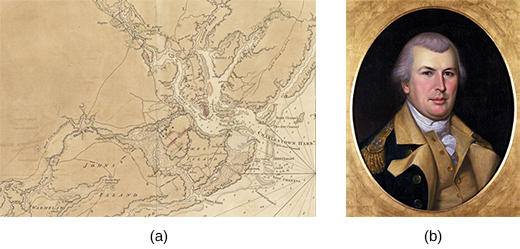| << Chapter < Page | Chapter >> Page > |

The disaster at Charleston led the Continental Congress to change leadership by placing General Horatio Gates in charge of American forces in the South. However, General Gates fared no better than General Lincoln; at the Battle of Camden, South Carolina, in August 1780, Cornwallis forced General Gates to retreat into North Carolina. Camden was one of the worst disasters suffered by American armies during the entire Revolutionary War. Congress again changed military leadership, this time by placing General Nathanael Greene ( [link] ) in command in December 1780.
As the British had hoped, large numbers of Loyalists helped ensure the success of the southern strategy, and thousands of slaves seeking freedom arrived to aid Cornwallis’s army. However, the war turned in the Americans’ favor in 1781. General Greene realized that to defeat Cornwallis, he did not have to win a single battle. So long as he remained in the field, he could continue to destroy isolated British forces. Greene therefore made a strategic decision to divide his own troops to wage war—and the strategy worked. American forces under General Daniel Morgan decisively beat the British at the Battle of Cowpens in South Carolina. General Cornwallis now abandoned his strategy of defeating the backcountry rebels in South Carolina. Determined to destroy Greene’s army, he gave chase as Greene strategically retreated north into North Carolina. At the Battle of Guilford Courthouse in March 1781, the British prevailed on the battlefield but suffered extensive losses, an outcome that paralleled the Battle of Bunker Hill nearly six years earlier in June 1775.
In the summer of 1781, Cornwallis moved his army to Yorktown , Virginia. He expected the Royal Navy to transport his army to New York, where he thought he would join General Sir Henry Clinton. Yorktown was a tobacco port on a peninsula, and Cornwallis believed the British navy would be able to keep the coast clear of rebel ships. Sensing an opportunity, a combined French and American force of sixteen thousand men swarmed the peninsula in September 1781. Washington raced south with his forces, now a disciplined army, as did the Marquis de Lafayette and the Comte de Rochambeau with their French troops. The French Admiral de Grasse sailed his naval force into Chesapeake Bay, preventing Lord Cornwallis from taking a seaward escape route.
In October 1781, the American forces began the battle for Yorktown, and after a siege that lasted eight days, Lord Cornwallis capitulated on October 19 ( [link] ). Tradition says that during the surrender of his troops, the British band played “The World Turned Upside Down,” a song that befitted the Empire’s unexpected reversal of fortune.

Notification Switch
Would you like to follow the 'U.s. history' conversation and receive update notifications?